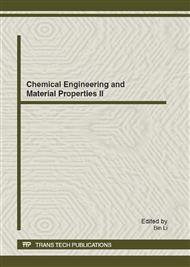p.147
p.152
p.157
p.161
p.167
p.172
p.177
p.183
p.188
Rapid Determination of Chemical Oxygen Demand in Sugar Refinery Wastewater by Short-Wave Near-Infrared Spectroscopy
Abstract:
Near-infrared (NIR) spectroscopy combined with partial least squares (PLS) regression and Savitzky-Golay (SG) smoothing was successfully applied for the rapid no-reagent determination of chemical oxygen demand (COD) in sugar refinery wastewater. Among 141 samples, 60 were randomly selected as the validation set. The remaining 81 samples were divided into the calibration set (50 samples) and the prediction set (31 samples) for a total of 20 times with certain similarities. The results showed that the short-wave NIR region (780 nm to 1100 nm) can be used as information waveband of COD in sugar refinery wastewater. The optimal SG smoothing parameters and PLS factors OD, DP, NSP, and F were 5, 5, 7, and 6, respectively. The modeling effects M-SEPAve, M-RP,Ave, M-SEPStd, and M-RP,Std were 24.3 mg/L, 0.971, 2.7 mg/L, and 0.007, respectively. The validation effects V-SEP and V-RP were 25.9 mg/L and 0.963, respectively. The results indicated that the method has good prediction effect and stability, and provided a reliable analysis model and valuable references for designing specialized instruments.
Info:
Periodical:
Pages:
167-171
Citation:
Online since:
July 2012
Authors:
Price:
Сopyright:
© 2012 Trans Tech Publications Ltd. All Rights Reserved
Share:
Citation:


